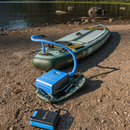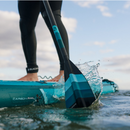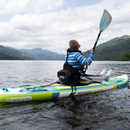How to Store Paddle Boards? [3 Ways & Instructions]

Storing your board properly is crucial to years of on-the-water adventure. Dive into our guide to on how to store paddle board properly and give it the attention it deserves.
Why Is Paddle Board Storage is Important?
A paddle board isn't just a piece of sports equipment. Think of your paddle board as a pet; it needs care, affection, and a proper resting place. Proper paddle board storage keeps your paddle board looking fresh and clean and helps it perform better and last longer, looking so spiffy you'll turn heads every time you hit the water.
Basic Principles of Paddle Board Storage
So you've got a paddle board and want to keep it in good shape for a long time. Here’s your straightforward guide on how to do just that.
Ideal Paddle Board Storage Conditions
What is the ideal place to store your SUP?
Whether you have a hard or inflatable SUP, it's best to store it indoors under the following conditions:
- Dry Air: Keep your board away from damp spots to avoid mold and those ugly mildew stains.
- No Direct Sun: Sunlight can fade your board and weaken the materials it’s made of. If you must store it where some sun gets in, using sun protection foil or a storage bag can help.
- Not Too Hot or Cold: Your board doesn't like extreme temperatures. Cooler is usually better, but steer clear of places where it might freeze.
Finding the right place helps your board last longer and stay in great shape for all your adventures.
Quick Tip: Before you put your board away, give it a good cleaning first. Wash off salt and dirt, paying extra attention to the handles and bungee cords. This keeps your board looking and feeling its best.
That’s it! Find a nice, dry place that’s not too hot or cold, and your paddle board will be ready and waiting for your next fun day out.
How to Clean Your Paddle Board Before Tucking It Away
Cleaning your paddle board is an investment in its longevity and your future aquatic thrill. Here are steps on how to clean a paddle board to make sure your board is fresh and ready for its next outing.
- First Rinse: Start by giving your paddle board a good rinse with fresh water. This will remove any immediate dirt, sand, and especially salt that could corrode the material over time.
- Soapy Clean: Up next, give it a wash with a gentle soap mixed with tap water. Avoid any strong chemicals that could harm your board. This step helps remove any stubborn grime or stains.
- Rinse Again: Get rid of all that soap with another thorough rinse. You're aiming to have your board as clean as possible before it's stored away.
- Dry it Out: Last but certainly not least, dry your board completely. Any leftover moisture could lead to mildew. While it's tempting to let the sun do the work, UV rays can actually harm your board, so opt for a shaded area for drying.
Follow these steps, and your paddle board will be clean, happy, and ready for another season of adventures.

=> Buy the Cleaning Kit for paddle boards at iROCKER.
Positioning and orientation
Just like you prefer sleeping in a certain position, your paddle board also has a preferred resting posture. Flat or on edge, that's how it likes to rest. Do not store on concrete or asphalt surfaces; flip the board so the top faces down to protect the EVA deck pad.

Using Proper Covers
A protective cover is like a warm blanket for your paddle board—it shields it from dust, moisture, and UV rays. Dress it up with a nice, protective cover, and it'll thank you by serving up endless good times on the water.
Best Ways to Store a Stand Up Paddle Board
Different strokes for different folks, they say. The same is true with paddle boards! Now, let's roll out the red carpet for different types of storage options:
- Store Paddle Boards On a Rack.
- Store Your Paddle Boards in a Suspension System.
- Store Your Paddle Boards by Leaning them Against a Wall.
Store Paddle Boards On a Rack
A well-designed and firm rack securely holds your board, maintaining its shape and protecting it from further damage. This approach not only turns your paddle board into a unique wall decoration but also saves valuable floor space. However, be mindful of your board's weight before suspending it. A robust wall rack would be the best option for heavier boards, offering visual appeal and structural support.
Store Your Paddle Boards in a Suspension System
Wondering how to store paddle boards in style while also being practical? Consider suspending them from the ceiling in your home or garage. This method not only elevates your paddle board into a work of art but also conserves floor space. It's a decor and storage solution that fits seamlessly into any room. But remember, before you hang it up, consider the weight of your board. Heavier boards may not be the best fit for suspended storage methods. A sturdy wall rack could be a wise choice in such cases, providing both aesthetics and stability.
By blending form and function, you can show off your paddle board as a masterpiece while ensuring it's in shape and ready for your next aquatic adventure.
Store Your Paddle Boards by Leaning them Against a Wall
Leaning the board against a wall is the paddle board equivalent of lounging on a recliner. It's a power nap. Quick, easy! If you're in a hurry or tight on space, just lean the board on its tail or lay it flat against the wall. However, make sure never to lean it on its nose, as this can harm the material and make it prone to tipping over. To make this method safer and to protect both the board and your wall, consider using some padding or a traction pad at the contact points.
While this method is convenient, it's not ideal for long-term storage.
How to Store Paddle Boards: Other Considerations

Life isn't one-size-fits-all, and neither are paddle boards! Let’s delve in to figure out:
Paddle Board Storage: Indoor Vs Outdoor
Can you store a paddle board outside? Yes.
While storing inside is generally better; however, if the call of the outdoors is too strong and you decide to store your paddle board outside, there are some special considerations to keep in mind.
- Outdoor Storage: Opt for a high-quality, weather-resistant cover to protect your paddle board from the elements. A well-chosen cover will shield your board from rain, sun, and other elements, essentially tucking it in for a safe night outside.
- Security Measures: Given the high cost of paddle boards, theft is a real concern. Make sure to invest in a solid lock or security system, especially when storing outside.
Paddle Board Storage: Long-term Vs Short-term Storage
When it comes to the duration of storage, think of short-term as your board's weekend getaway—a brief, easy-going respite until the next wave-catching session. For this, prioritizing easy access is key.
On the other hand, long-term storage is your board's resting period. It’s a big winter sleep calling for a deep cleaning, and a well-chosen, protected environment. If your paddle board will be out of action for more than a few weeks, aim for a cool, dry space like a garage or an indoor room to shield it from harsh elements.
Special Considerations for Inflatable Vs Solid Boards
- How to Store an Inflatable SUP
How to store an inflatable paddle board comes with its unique set of considerations, but it's all straightforward. If you have one of these versatile boards, it deserves special care.
- Even Weight Distribution: If you're keeping it inflated, make sure the weight is evenly distributed, especially if you're suspending or leaning it against a wall. An unbalanced board can deform at its pressure points over time.
- Strap Tightness: Straps should hold your SUP securely but not too tightly. Excessive heat and pressure could cause your SUP to deform.
- Summer Storage: If storing in non-climate-controlled spaces like sheds or garages during the warmer months, consider deflating your SUP to 3-5 PSI.
- Space-Saving: If you're tight on space, fully deflating the board is a good option. Ensure the board is clean and totally dry before you do this.
- Roll, Don't Fold: Open the valve and let all the air out once it's clean and dry. Roll it up gently rather than folding it tightly. Store it in its bag and keep it in a cool, dry spot indoors.
Whether you opt to keep it inflated for those spur-of-the-moment paddles or deflated for seasonal storage, these bullet points are your comprehensive guide for keeping your inflatable SUP in optimal condition for years of aquatic journeys.
- How to Store a Solid SUP
Think of storing your paddle boards as a balance between preservation and accessibility. Inflatable SUPs require special care, akin to hibernating wildlife. They're best deflated and stored safely to prevent deformation. On the other hand, solid boards are more resilient but still benefit from a protective cover.
- Fins Off: Always remove the fins to avoid potential damage during storage.
- Elevate: Keep your board off the ground to prevent dirt and moisture from accumulating.
- Distribute Weight: If you're storing your board on a rack or suspending it, make sure the weight is evenly distributed to prevent warping or scratching.
- UV Protection: If you're storing your board outdoors, a UV-resistant cover or a shaded area is essential for prolonging its life.
- Accessibility: Consider how frequently you'll use your board. Store it in a location where it's not cumbersome to access but also where it remains protected.
Storing your paddle boards with these considerations in mind ensures their longevity and keeps them ready for your next outing on the water.
Check up on your SUP after a While

Emerging from winter's chill or a long storage spell, inspecting your paddle board meticulously before hitting the waves again is crucial. If you've followed our guide on how to store paddle boards, chances are your board has fared well. But even the best-maintained boards can benefit from a springtime once-over.
- Pressure Test: Inflate your paddle board to the recommended PSI and observe. If it's losing air, it might be a loose valve. You'll need to deflate the board entirely and tighten the valve using a specialized wrench.
- Fin Inspection: Check the fin box and glued fins. Any deformities can often be resolved with a little heat from a hairdryer—just be cautious not to overheat and damage the material.
- Post-Winter Unfurl: If you've stored your board folded or rolled up, it's a good idea to fully inflate it and leave it for a day to help the material regain its original shape.
Treat your paddle board like the cherished possession it is, and you'll be rewarded with endless aquatic fun and cherished memories.
And there you have it! The ultimate guide on how to store paddle boards, hopefully full of information. If you found this article helpful, check out our blogs on the best treatment for your SUP. Remember, treat your paddle board like the superstar it is! Now, ride the wave!






